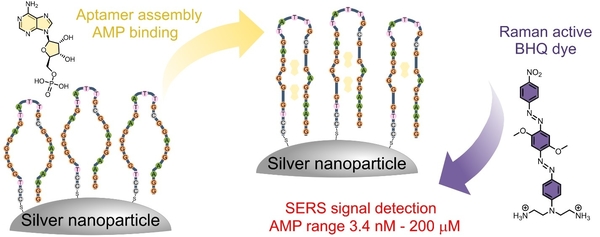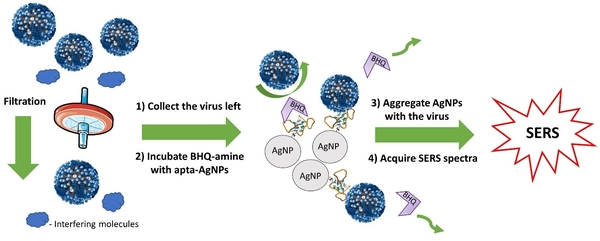Press-room / news / Science news /
Positively charged black hole quencher (BHQ) derivatives as external SERS active responsive elements of biosensors
Scientists from the Group of molecular tools for living system studies (IBCh RAS), Department of chemistry of Natural Compounds (Faculty of Chemistry, MSU) and Osipyan Institute of Solid State Physics, together with the Laboratory of Molecular Design and Synthesis (IBCh RAS), have developed external SERS-active responsive elements based on positively charged black hole quencher (BHQ) derivatives.

Zavyalova E, Tikhonova D, Zhdanov G ,Rudakova E, Alferova VA, Moiseenko A, Kamzeeva PN, Khrulev AA, Zalevsky A, Arutyunyan A, Novikov R, Kukushkin V, Aralov AV

Zhdanov G, Nyhrikova E, Meshcheryakova N, Kristavchuk O, Akhmetova A, Andreev E, Rudakova E, Gambaryan A, Yaminsky I, Aralov AV, Kukushkin V & Zavyalova E
Most aptasensors have a complex structure and contain non-canonical structural ensembles such as G-quadruplexes and i-motifs. To interact with such structures, the compound should contain an extended aromatic system, which allows for efficient stacking with nucleobases, and positively charged alkyl groups interacting with a negatively charged sugar-phosphate backbone. In addition, to generate a Raman signal, the molecule should have a high molar extinction coefficient at the laser excitation wavelength (532 nm) and a low fluorescence quantum yield. The core of the well-known quenchers BHQ-1 and BHQ-2, which have an almost zero fluorescence quantum yield, was chosen as the extended aromatic system. BHQ-1 and BHQ-2 were further modified with positively charged alkyl groups to interact with nucleic acid backbone. The obtained compounds were probed as a part of biosensors:
1) A biosensor based on DNA aptamer for the quantitative determination of adenosine monophosphate (AMP).
Among the compounds developed, a derivative of BHQ-2 with two aminoethyl groups, BHQ-2-(NH2)2, interacts with unpaired guanine stacked between guanine-guanine and guanine-adenine mismatches in the DNA aptamer-AMP complex with KD = 26 nM and compete with AMP for the aptamer binding. The interplay between the aptamer, its analyte (AMP) and BHQ-2-(NH2)2 made it possible to develop a rapid and robust SERS-based biosensor with a limit of detection of 3.4 nM and the dynamic range of almost 5 orders of magnitude (3.4 nM-200 µM).

2) A biosensor based on DNA aptamer for the qualitative determination of influenza virus particles.
In the case of this biosensor, BHQ-2-(NH2)2 competes with the virus for binding to the G-quadruplex, which is the core structure of the aptamer. The biosensor functions even with aliquots of the biological fluids due to separation of the off-target molecules by pre-filtration through a polymeric membrane and provides a limit of detection of 103 particles per ml of influenza A virus, which approaches the sensitivity of RT-PCR methods.

In conclusion, the proposed derivatives as external responsive elements can increase sensitivity, simplify biosensors and reduce their cost, as well as speed up the process of quantitative and qualitative analyte determination. The study results are published in Analytica Chimica Acta (IF 6.911) and Frontiers in chemistry (IF 5.545).
july 8, 2022

